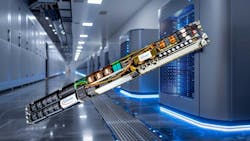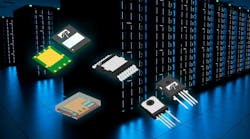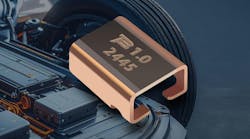12-kW High-Density PSU Ref Design Aimed at AI Data Centers and Servers
A new 12-kW reference design for high-performance power-supply units (PSUs) from Infineon Technologies is specifically designed for AI data centers and server applications.
The reference design uses a carefully selected combination of silicon, silicon-carbide (SiC), and gallium-nitride (GaN) devices to produce a cost-effective PSU architecture that achieves high efficiency and high power density. Targeted users include research and development engineers, hardware designers, and developers of power electronics systems.
To achieve high-performance levels, the design leverages advanced power-conversion topologies in both the AC-DC and DC-DC power stages. The front-end AC-DC converter features a three-level flying-capacitor, interleaved power-factor-correction (PFC) topology that delivers peak efficiency above 99.0% while reducing magnetic component volume. The front end makes extensive use of devices fabricated with Infineon’s CoolSiC technology, which offers high switching performance and excellent thermal properties.
The isolated DC-DC converter features a full-bridge LLC resonant converter and offers peak efficiency above 98.5%, made possible by using two planar high-frequency transformer and Infineon’s CoolGaN technology. These architectures, combined with Infineon’s latest wide-bandgap technologies, achieve a power density of up to 113 W/in3.
Another key feature of the 12-kW PSU reference design is its integrated bidirectional energy buffer. It enables compliance with hold-up time requirements while significantly reducing capacitance requirements. Furthermore, the energy buffer provides a grid-shaping function, improving system reliability and limiting both fluctuations and the rate of change of power drawn from the grid during transient events.
Next in This Edition of PowerBites
More PowerBites
About the Author
Lee Goldberg
Contributing Editor
Lee Goldberg is a self-identified “Recovering Engineer,” Maker/Hacker, Green-Tech Maven, Aviator, Gadfly, and Geek Dad. He spent the first 18 years of his career helping design microprocessors, embedded systems, renewable energy applications, and the occasional interplanetary spacecraft. After trading his ‘scope and soldering iron for a keyboard and a second career as a tech journalist, he’s spent the next two decades at several print and online engineering publications.
Lee’s current focus is power electronics, especially the technologies involved with energy efficiency, energy management, and renewable energy. This dovetails with his coverage of sustainable technologies and various environmental and social issues within the engineering community that he began in 1996. Lee also covers 3D printers, open-source hardware, and other Maker/Hacker technologies.
Lee holds a BSEE in Electrical Engineering from Thomas Edison College, and participated in a colloquium on technology, society, and the environment at Goddard College’s Institute for Social Ecology. His book, “Green Electronics/Green Bottom Line - A Commonsense Guide To Environmentally Responsible Engineering and Management,” was published by Newnes Press.
Lee, his wife Catherine, and his daughter Anwyn currently reside in the outskirts of Princeton N.J., where they masquerade as a typical suburban family.
Lee also writes the regular PowerBites series.





